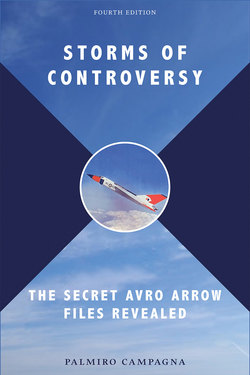Читать книгу Storms of Controversy - Palmiro Campagna - Страница 9
ОглавлениеPREFACE TO THE THIRD PAPERBACK EDITION
In this latest edition of Storms of Controversy, I add to a new appendix (Appendix II) information about the Arrow that came to light in 1997, and I have included more previously unseen declassified documents.
The Arrow controversy remains alive and well. Proof of this was provided in an interview by the Canadian Press with former Conservative Cabinet minister Pierre Sevigny in February 1998, which was published in every major newspaper across Canada. In the interview, Sevigny claimed that the destruction of the Avro Arrow was ordered by A.V. Roe president Crawford Gordon. Sevigny and the Canadian Press ignored the entire paper trail of government documents I provided in the first edition of this book in 1992. In the ensuing firestorm of public opinion, Sevigny admitted that he had not seen these documents. Too often the word of such individuals is taken as truth simply because of their claims of involvement, but mostly these people talk out of their hats because they are not privy to inside information. As a result, rumours and accusations are easily spread and the debate quickly degenerates into an emotional, factless argument.
Controversy about the Arrow also lives on in cyberspace — numerous websites are devoted to the issue. As well, there are many projects afoot to build small- and full-scale replicas of the Arrow. There is even talk that the United States might return the Avrocar to Canada. One model has languished in a hangar at the Smithsonian Institution in Washington, D.C., since it was delivered to the United States in the early 1960s, and the other rests atop a pedestal at Fort Eustis, Virginia. I have discussed the Avrocar project in detail in my book The UFO Files: The Canadian Connection Exposed. The CBC has aired a television movie called The Arrow that, though primarily a work of fiction, features many original flying sequences of the Arrow, beautifully restored.
In 1997, the Avro mole, a spy code-named Gideon, long thought to have died in the Soviet Union, reappeared in Canada. Gideon has been implicated in the Soviet attempt to steal Arrow manufacturing secrets. The exact roles he and the KGB played in the Arrow affair have yet to be determined. I urge anyone with new, legitimate information about Gideon and this covert episode to come forward.
There are also questions about the Arrow story that no one seems to ask. Why did several government officials remain silent about their involvement in the destruction of the Arrow, even though their names appear on the orders to blowtorch the aircraft into scrap? Why did all these people lie low, allowing John Diefenbaker to twist in the wind? These questions may never be answered completely because many of the people involved are dead and denial of involvement runs deep.
James Dow, in his 1979 book The Arrow, wrote of the alleged meeting between A.V. Roe president Crawford Gordon and Prime Minister John Diefenbaker in September 1958. Dow states that this encounter with a drunken, rude Gordon pushed Diefenbaker to cancel. The only eyewitness to this event, according to Dow, was the Ottawa Journal’s Grattan O’Leary. He was in an adjoining room when he overheard this discussion. O’Leary saw Gordon exit the room and Diefenbaker come out immediately afterward. In his memoirs, Diefenbaker does not place much significance on this meeting.
Greig Stewart, in his 1998 book Arrow Through the Heart, describes a less volatile encounter between Diefenbaker and Gordon, but also maintains that the argument sealed the Arrow’s fate. But Stewart states that it was Member of Parliament John Pallett and not Grattan O’Leary who was in the next room. Unless the prime minister had more than one adjoining room at the time, one or both of these two stories is incorrect. The truth and significance of this meeting may lie only in Diefenbaker’s personal memoirs.
In the new appendix, supported by documentation, I finally establish the true costs of the Arrow program, and I have added intriguing information from former Minister of National Defence George Pearkes in interviews he gave to Dr. Reginald Roy of the University of Victoria in 1967 that are only now resurfacing.
The new information and documents I provide on the Arrow and all of the recent developments about the story are testimony to the strength of the ongoing controversy. I wish to thank the legion of readers who have made Storms of Controversy an overwhelming success. I would like to thank the staff of the Special Collections Branch of the University of Victoria, Chris Petter in particular, for allowing me to quote from the interviews between Pearkes and Roy; my editor, Jim Gifford; the staff at Stoddart; and for inspiration, my newborn daughter, Katia Marie.
Orleans, Ontario
May 1998
